
Identification, friend or foe (IFF) is a combat identification system designed for command and control. It uses a transponder that listens for an interrogation signal and then sends a response that identifies the broadcaster. IFF systems usually use radar frequencies, but other electromagnetic frequencies, radio or infrared, may be used. It enables military and civilian air traffic control interrogation systems to identify aircraft, vehicles or forces as friendly, as opposed to neutral or hostile, and to determine their bearing and range from the interrogator. IFF is used by both military and civilian aircraft. IFF was first developed during World War II, with the arrival of radar, and several friendly fire incidents.

In aviation, distance measuring equipment (DME) is a radio navigation technology that measures the slant range (distance) between an aircraft and a ground station by timing the propagation delay of radio signals in the frequency band between 960 and 1215 megahertz (MHz). Line-of-visibility between the aircraft and ground station is required. An interrogator (airborne) initiates an exchange by transmitting a pulse pair, on an assigned 'channel', to the transponder ground station. The channel assignment specifies the carrier frequency and the spacing between the pulses. After a known delay, the transponder replies by transmitting a pulse pair on a frequency that is offset from the interrogation frequency by 63 MHz and having specified separation.

The Naxos radar warning receiver was a World War II German countermeasure to S band microwave radar produced by a cavity magnetron. Introduced in September 1943, it replaced Metox, which was incapable of detecting centimetric radar. Two versions were widely used, the FuG 350 Naxos Z that allowed night fighters to home in on H2S radars carried by RAF Bomber Command aircraft, and the FuMB 7 Naxos U for U-boats, offering early warning of the approach of RAF Coastal Command patrol aircraft equipped with ASV Mark III radar. A later model, Naxos ZR, provided warning of the approach of RAF night fighters equipped with AI Mk. VIII radar.

Freya was an early warning radar deployed by Germany during World War II; it was named after the Norse goddess Freyja. During the war, over a thousand stations were built. A naval version operating on a slightly different wavelength was also developed as the Seetakt.

The low-UHF band Würzburg radar was the primary ground-based tracking radar for the Wehrmacht's Luftwaffe and Kriegsmarine during World War II. Initial development took place before the war and the apparatus entered service in 1940. Eventually, over 4,000 Würzburgs of various models were produced. It took its name from the city of Würzburg.

The history of radar started with experiments by Heinrich Hertz in the late 19th century that showed that radio waves were reflected by metallic objects. This possibility was suggested in James Clerk Maxwell's seminal work on electromagnetism. However, it was not until the early 20th century that systems able to use these principles were becoming widely available, and it was German inventor Christian Hülsmeyer who first used them to build a simple ship detection device intended to help avoid collisions in fog. True radar which provided directional and ranging information, such as the British Chain Home early warning system, was developed over the next two decades.

Jagdschloss, officially the FuG 404, was the designation of a German early warning and battle control radar developed just prior to the start of World War II. Although it was built in limited numbers, Jagdschloss is historically important as the first radar system to feature a plan position indicator display, or "PPI". In Germany this type of display was referred to as "Panorama". It is named for Jagdschloss, a hunting lodge.
During World War II, the German Luftwaffe relied on an increasingly diverse array of electronic communications, IFF and RDF equipment as avionics in its aircraft and also on the ground. Most of this equipment received the generic prefix FuG for Funkgerät, meaning "radio equipment". Most of the aircraft-mounted Radar equipment also used the FuG prefix. This article is a list and a description of the radio, IFF and RDF equipment.
Wilhelm Tolmé Runge was a German electrical engineer and physicist who had a major involvement in developing radar systems in Germany.
Radar in World War II greatly influenced many important aspects of the conflict. This revolutionary new technology of radio-based detection and tracking was used by both the Allies and Axis powers in World War II, which had evolved independently in a number of nations during the mid 1930s. At the outbreak of war in September 1939, both the United Kingdom and Germany had functioning radar systems. In the UK, it was called RDF, Range and Direction Finding, while in Germany the name Funkmeß (radio-measuring) was used, with apparatuses called Funkmessgerät . By the time of the Battle of Britain in mid-1940, the Royal Air Force (RAF) had fully integrated RDF as part of the national air defence.

Radar, Aircraft Interception, Mark IV, also produced in the USA as SCR-540, was the world's first operational air-to-air radar system. Early Mk. III units appeared in July 1940 on converted Bristol Blenheim light bombers, while the definitive Mk. IV reached widespread availability on the Bristol Beaufighter heavy fighter by early 1941. On the Beaufighter, the Mk. IV arguably played a role in ending the Blitz, the Luftwaffe's night bombing campaign of late 1940 and early 1941.

Radar, Aircraft Interception, Mark VIII, or AI Mk. VIII for short, was the first operational microwave-frequency air-to-air radar. It was used by Royal Air Force night fighters from late 1941 until the end of World War II. The basic concept, using a moving parabolic antenna to search for targets and track them accurately, remained in use by most airborne radars well into the 1980s.
The Kehl-Straßburg radio control link was a German MCLOS radio control system of World War II. The system was named for Strasbourg, the French/German city on the Rhine and Kehl, at the time a suburb of Strasbourg. It was used by the Fritz X guided bomb and the Henschel Hs 293 guided missile, and would also be trialled in test of the Henschel Hs 298 MCLOS-guidance air-to-air missile.
German Luftwaffe and Kriegsmarine Radar Equipment during World War II, relied on an increasingly diverse array of communications, IFF and RDF equipment for its function. Most of this equipment received the generic prefix FuG, meaning "radio equipment". During the war, Germany renumbered their radars. From using the year of introduction as their number, they moved to a different numbering scheme.

IFF Mark II was the first operational identification friend or foe system. It was developed by the Royal Air Force just before the start of World War II. After a short run of prototype Mark Is, used experimentally in 1939, the Mark II began widespread deployment at the end of the Battle of Britain in late 1940. It remained in use until 1943, when it began to be replaced by the standardised IFF Mark III, which was used by all Allied aircraft until long after the war ended.

IFF Mark III, also known as ARI.5025 in the UK or SCR.595 in the US, was the Allied Forces standard identification friend or foe (IFF) system from 1943 until well after the end of World War II. It was widely used by aircraft, ships, and submarines, as well as in various adaptations for secondary purposes like search and rescue. 500 units were also supplied to the Soviet Union during the war.
IFF Mark X was the NATO standard military identification friend or foe transponder system from the early 1950s until it was slowly replaced by the IFF Mark XII in the 1970s. It was also adopted by ICAO, with some modifications, as the civilian air traffic control (ATC) secondary radar (SSR) transponder. The X in the name does not mean "tenth", but "eXperimental". Later IFF models acted as if it was the tenth in the series and used subsequent numbers.
Perfectos was a radio device used by Royal Air Force's night fighters during the Second World War to detect German aircraft. It worked by triggering Luftwaffe's FuG 25a Erstling identification friend or foe (IFF) system and then using the response signal to determine the enemy aircraft's direction and range. This allowed RAF interceptors to track the Germans without the need for a radar system of their own, in contrast to the earlier Serrate radar detector that lacked range information and thus required a radar of their own for the final approach.

AMES Type 6, also known as the Light Warning Set or L/W, was a portable early warning radar developed by the Air Ministry Experimental Station (AMES) for use by the Royal Air Force (RAF) in the field. Units in British Army service were officially known as Radar, Anti-Aircraft, Number 4, or AA. No. 4 for short, although this name was rarely used in practice. The system was also built in Canada for use by the US Army, who referred to them as SCR-602-A.












